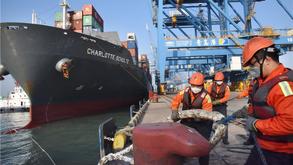 Port employees help a cargo vessel dock at the container terminal of Qingdao Port, Shandong province. (PHOTO / XINHUA)
Port employees help a cargo vessel dock at the container terminal of Qingdao Port, Shandong province. (PHOTO / XINHUA)
BRUSSELS - A contraction in global trade in services caused by the COVID-19 pandemic is showing signs of bottoming out, the World Trade Organization said on Thursday as its trade barometer index fell to a record low.
The WTO services trade barometer is a composite of data on purchasing manager indexes, financial transactions, IT services, passenger flights, container shipping and building permits
The WTO’s trade barometer for services, which is published twice a year, fell to 95.6 points from the 96.8 reading reported in March. Readings below 100 indicate trade growth below medium-term trends.
“The barometer’s measures are in aggregate outperforming recent trends in actual services trade, a gap that in the past has preceded a positive shift in trade momentum,” the WTO said.
READ MORE: Service trade key to driving growth
The WTO services trade barometer is a composite of data on purchasing manager indexes, financial transactions, IT services, passenger flights, container shipping and building permits.
It is designed to identify turning points and gauge momentum in global trade growth rather than to provide a specific short-term forecast.
Passenger air travel was by far the heaviest hit sector, with a reading of 49.2 weighing on the overall index, although it too appeared to have stabilised recently.
ALSO READ: Agriculture, service trade to boost ties with CEEC
The sub-indices for container shipping, construction, IT services and the global purchasing managers’ index were all in the 90s. Only financial services, at 100.3, was around the mid-term trend this month.
The WTO said the volume of services trade fell by 4.3% in the first quarter of 2020 from a year earlier. This was not as sharp a drop as the 5.1% during the financial crisis in the first three months of 2009 and the 8.9% slump the following quarter.


